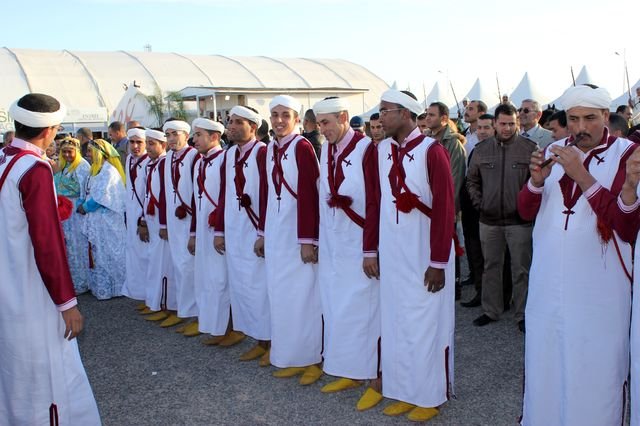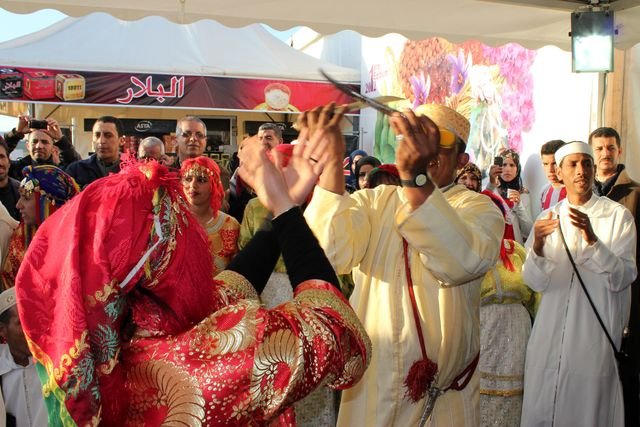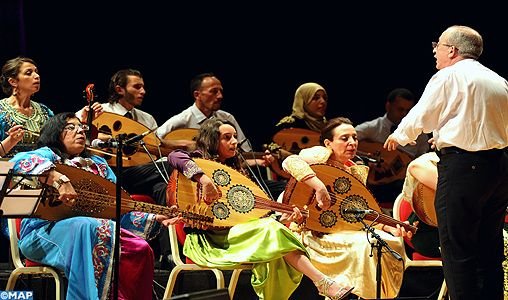In Morocco the musical and choreographic heritage has been transmitted orally from generation to generation, according to learning rules governed by the master-disciple relationship. Two musical genres predominate schematically: rural music, essentially characterized by rhythm, and city music mainly inspired by the Andalusian heritage. Collective dances are as numerous as tribes. They associate themselves with folk poetry declaimed or sung. They present many variants of which the best known are “ahidouss” and “ahwach”.

photo 1: the dance''ahwach"
image source

photo 2: the dance''ahidouss"
image source
Rural music:
For most Berber expression, styles vary by region. The Sous is distinguished by small itinerant orchestras, "the rwayes", which interpret poems with a moral and political character, but also with more frivolous themes. They play "rebab" (here, old monochord), "lotar" (stringed instrument whose case is a pan wrapped in skin) and metal percussion. Their show is also composed of dances, stampings of the feet in particular.

photo3: the dance''CHAIBI"
image source
In the Middle Atlas, the "chikhates", singers and dancers liberated mores, are accompanied by a small orchestra: violin, percussion, possibly lute. The guedra of Guelmim region is a dance without displacement, punctuated by a drum terracotta. The art of the dancer lies in her movements of arms and hands.
Music among rural Arabs is similar to "melhoun", but it is distinguished by more varied and dancing rhythms.
"Tarifiyit" or "jahjouka" practiced in the Rif. It was revealed to the Western world by the Rolling Stones after the compositions of Brian Gysin who inspired it.
Tamazight in the center in the Middle Atlas. The main dance of these regions is "Ahidouss".
"Tachelhit" to the south in the top and the Anti-Atlas. The main dance is "Ahwach".
City music:
Coming from the East, Andalusian music developed in "Andalus", then, from the 11th century, was brought to North Africa by the Arabs expelled from Spain. In Morocco, it is called "al-'âla", that is to say "the instrument". This musical tradition, aristocratic, has continued until today, in Fez and Tetouan, but also in Rabat and Oujda. Socially connoted, it is reserved for amateur concerts and celebrations of Moroccan high society. The repertoire includes eleven nouba, or suites, of five movements each. These are mostly love poems collected in a collection in the eighteenth century. by "Al Hdik", a musician from Tetouan. The "nouba", directed by the soloist, is sung in unison by the instrumentalists and sometimes by a choir of women.
Very inspired by Andalusian music, but more popular, the "melhoun" is a genre where Moroccan Arabic poems predominate over music.
His accompaniment is simpler. The solo singer occupies the central place in the orchestra, composed of "oud", "târ", "derbouka" and "nouiqsat" (digital jingles).

photo4: Andalousi music
image source
Morocco is very rich culture of music
This is so informative and beautiful, thanks so much for sharing @yassine2014! Wonderful images, too.
THANK YOU FOR THIS POSITIVE NOTE.
Really interesting to know about different cultures! Morocco is a beautiful country!
Thank you @monajam for the participation. Morocco is the richest country of the musical culture. Follow me. I am going to publish several posts on the culture and the traditionnal maroccan
Followed :)
I look forward to your posts. Do you also make videos? Would be nice if you show us your country in videos.
thank you monajam ,yes I will make video
This post has received a 3.72 % upvote from @boomerang thanks to: @yassine2014
Thank you @boomerang
Upvote with 100% by @votebuster
Thank you @boomerang
This post was resteemed by @steemvote and received a 6.09% Upvote